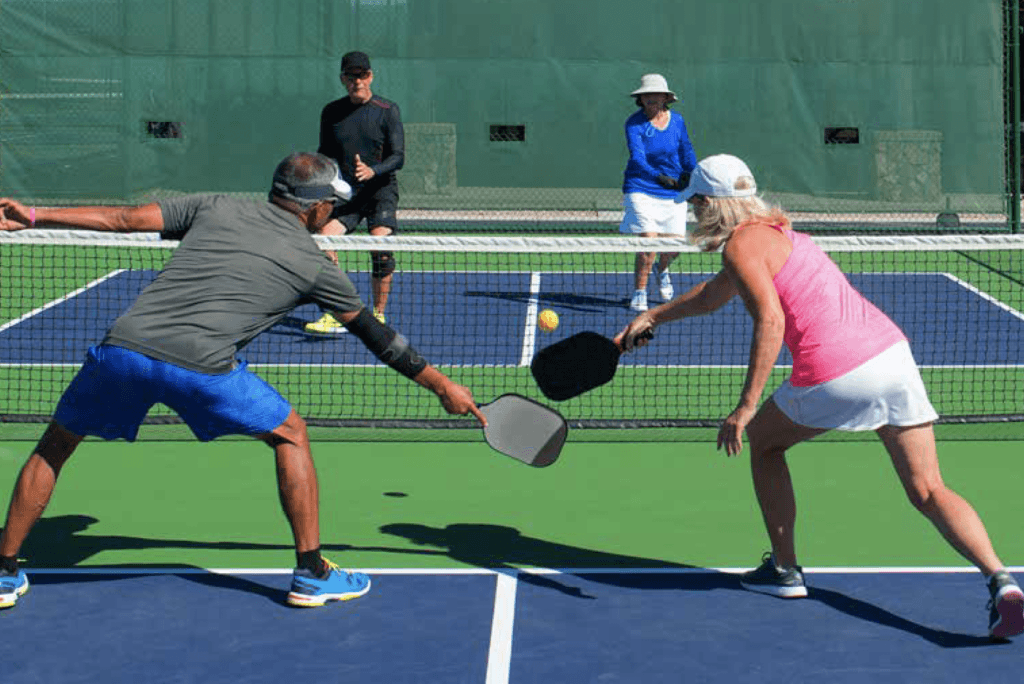

Brain and Body Benefits of Pickball
by Guest Author
Playing pickleball provides many brain health and physical health benefits. Ryan Glatt, CPT, NBC-HWC, senior brain health coach and director of the FitBrain Program at Pacific Neuroscience Institute in Santa Monica, California, explains.
Excerpted and adapted from “Pickleball: Participation, passion and fractures on the rise” by Marilynn Larkin, MA, from The Journal on Active Aging 2024, Volume 23, Issue 2.
Pickleball: Participation, passion and fractures
Pickleball has taken the United States, Australia, and, well, the world by storm, making the sport a compelling topic to explore. In the US alone, participation increased 52% between 2022 and 2023, to 13.6 million players. What’s more, players ages 55 and up were the largest age bracket of pickleball players in 2021, comprising 19.8% of total US participants, recent statistics show.
The draw of pickleball

Widely described as a combination of tennis, badminton and ping pong, pickleball is played with a paddle and a plastic ball on a smaller court than tennis. Experts attribute its rapid popularity to factors such as the ease of play, the low cost of entry and the social aspects of the sport. Pickleball can be learned quickly—often in just a few lessons—and players can find tournaments at varying competitive levels. Additionally, pickleball generally is more affordable than tennis or golf.
But the number-one reason for the surging participation is simple: It’s fun!
Injuries on the rise
Unfortunately, all that fun often does come with a downside—namely, injuries. A study presented last year at the American Academy of Orthopedic Surgeons annual meeting found a 90-fold increase in pickleball-related fractures from 2002 to 2022, with fractures more than doubling since 2020. Most common are upper-extremity fractures in women ages 65 and older following a fall. But these people want to continue to be active, so activities like pickleball are still a good option.
Multiple benefits with reasons to play
Despite its injury risks, pickleball offers other important benefits for players beyond physical and cognitive health that make it an attractive amenity for individuals and organizations alike. Engaging in activities that keep us fit and social are very important for living life with increased quality, not just quantity in terms of years.
Neuromotor workout of pickleball
“Pickleball is what we call a neuromotor activity,” comments Ryan Glatt, CPT, NBC-HWC, senior brain health coach and director of the FitBrainSM Program at Pacific Neuroscience Institute in Santa Monica, California. “That means it’s similar to other racquet sports, as well as dance or martial arts, compared to, say, aerobic exercise or resistance training. While pickleball can have aerobic benefits, it’s primarily a neuromotor sport because of its demands on skills such as dynamic balance, hand-eye coordination, reaction time, and spatial orientation.”
Glatt, a past presenter at the International Council on Active Aging Conference, continues, “Players might be stepping in different directions. They might be reaching for a ball. They might be going through a process called motor planning, as they need to predict where they’re going. They have to have what’s called ‘impulse control’ in place—that is, they need to be able to control their impulses to execute a backhand or forehand swing. They have to anticipate where the ball is coming from and what their opponent will do. And they have to communicate with their team members if they’re playing doubles.”
Skill training & dual tasking
All those moves require what’s called open-skill training, which is more unpredictable than closed-skill training, like working out on a machine or treadmill, Glatt explains. “The open-skill acquisition process, even though it can cause some frustration, is a way of learning that’s actually quite good for the brain,” he notes. In fact, some research has shown that open-skill training for activities such as racquet sports may enhance cognitive function more than closed skills. That benefit is particularly important for Glatt’s clients who have cognitive issues, as well as healthy older adults. Working in a one-on-one context or in groups, he focuses on “dual tasking”—that is, doing one activity that’s physical, like a dynamic balance exercise, and one that’s cognitive, such as responding to a number, at the same time.
“This type of training can help prepare people for the cognitive and physical demands that are simultaneously occurring during an activity like pickleball,” he says. “For example, I have them step out in different directions in response to a visual stimulus such as a ball on a screen, at varying speeds. They need to respond to the visual stimulus immediately with the appropriate action.”
Injury prevention programs & support

A personal trainer, Glatt has found that orthopedic injuries, mainly from overuse, are common among the people he works with. “Many of us know at least one person in our lives who is kind of addicted to pickleball,” he says. “They’re wearing 20 different braces and bandages because the shoulder and the knee are being overused, for example. That’s true for anyone who either doesn’t train for their sport or overdoes the sport.”
Fall risk, balance & joint health assessment
Glatt also points to the risk of falls, which have happened even among individuals who would not normally be considered at risk. “People may become distracted by their teammates or the ball, and they forget to focus on stability,” he comments. “When people get competitive and reach outside or step outside their bubble of stability, they can have a tumble, which could potentially lead to things like concussions or traumatic brain injuries.”
That’s why, before individuals start playing pickleball, Glatt recommends they consult a physical therapist to have their balance and their joint health evaluated, and to ensure that they have the baseline fitness level to participate in pickleball at a basic level. “Furthermore, similar to a resistance-training program where you don’t start lifting heavy weights right away, you don’t start playing competitively right away either,” he stresses. “At the beginning, people should be focused more on the process of skill acquisition than competitive play.”
Pickleball safety
Organizations that work with active older adults should consider launching injury-prevention as well as fall-prevention programs in tandem with pickleball programming, Glatt suggests. The services of a fitness trainer or physical therapist should be available, as well.
“Organizations should also explore incorporating dual-tasking exercises and other open-skill activities such as table tennis into their programming,” he says, “in order to make even more comprehensive cognitive-motor demands on their residents.”
It is important for organizations to support their constituents in their efforts to play, particularly by providing practice with quick side-to-side movements which increase the forces across the tendons and joints in ways that are different from what most people are used to. Some physical training activity to get them individuals in shape before they start playing is an important way to help prevent injury.
By addressing injury risks with programming and support, active-aging settings can harness the popularity and passion for pickleball to encourage more constituents to enjoy this pathway to wellness.
Keeping fit in brain and body
Pacific Neuroscience Institute’s Brain Wellness & Lifestyle program offers in group or individual sessions, both virtually or in-person, for people interested in optimizing their brain health over the lifespan. Participants engage in dual tasking activities at the FitBrain gym where they perform cognitive and physical activities at the same time to help optimize brain function. Click here to learn more, or call 213-344-2037.
About Ryan Glatt

Ryan Glatt, CPT, NBC-HWC, is a Certified Personal Trainer and a National Board-Certified Health & Wellness Coach with over a decade of experience. He focuses his exercise and health coaching strategies on brain health, personalizing lifestyle interventions for individuals with brain and cognitive health goals. Ryan is a Brain Health Coach and the Director of the FitBrainSM Program at Pacific Neuroscience Institute.
Useful Links
Last updated: June 29th, 2024



